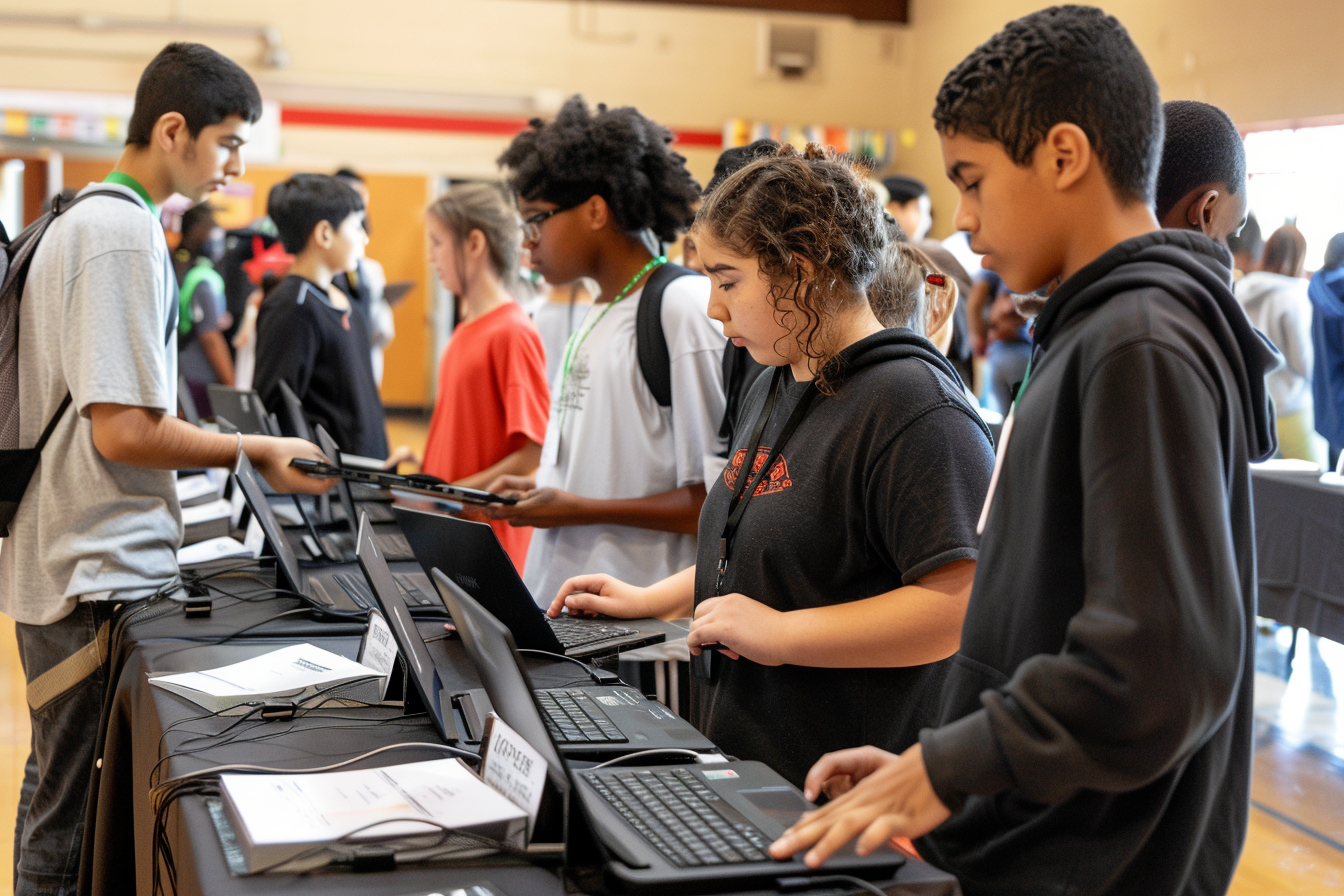Bridging the Digital Divide: Innovative EdTech Solutions for Equitable Education
Discover affordable EdTech strategies to close the digital divide, expand access, and ensure equitable, future-ready learning for all students.

Imagine a classroom where every student has equal access to the digital tools they need to succeed. In today's tech-driven world, the digital divide creates significant barriers to equitable education. Students without access to modern technology and the internet are at a distinct disadvantage, impacting their ability to learn and thrive.
The digital divide is not just a matter of having or not having devices; it encompasses disparities in digital literacy, internet connectivity, and the ability to utilize technology effectively. The COVID-19 pandemic has brought this issue to the forefront, highlighting the urgent need for innovative solutions.
We explore how leveraging EdTech solutions can bridge the digital divide, ensuring all students have access to quality education. From affordable devices and internet access to mobile learning and community Wi-Fi initiatives, we will delve into the various types of EdTech solutions, their benefits, and practical implementation strategies. Discover how these approaches can transform education, promote social equity, and prepare students for the future.
Understanding the Digital Divide
The digital divide refers to the gap between those who have access to modern information and communication technology and those who do not. This disparity can significantly impact education, as students without access to technology or the internet are at a disadvantage. The digital divide is often seen along socio-economic, geographic, and demographic lines, affecting marginalized communities the most.
Historically, the digital divide emerged with the rapid advancement of technology in the late 20th century. As educational systems increasingly rely on digital tools for teaching and learning, the divide has become more pronounced. The COVID-19 pandemic further highlighted this issue, as remote learning became essential and many students struggled to keep up due to lack of access.
Enjoy science fiction? Check out my space books HERE on Amazon!
Addressing the digital divide is crucial for ensuring that all students have equal opportunities to succeed. By understanding the scope and impact of this issue, educators and policymakers can implement effective solutions to bridge the gap and promote equitable education.
Types of Innovative EdTech Solutions
Understanding and addressing the digital divide involves leveraging various EdTech solutions. Here are some key types:
- Affordable Devices and Internet Access: Programs that provide low-cost laptops, tablets, and internet access to students in need. Initiatives like these ensure that all students have the necessary tools to participate in digital learning.
- Cloud-Based Learning Platforms: Utilizing cloud technology to provide access to educational resources, assignments, and collaborative tools. Platforms like Google Classroom and Microsoft Teams enable students to access learning materials from any device with internet connectivity.
- Mobile Learning: Leveraging smartphones and mobile apps to deliver educational content. This approach is particularly effective in regions where mobile phone penetration is high but computer access is limited. Apps can offer interactive lessons, quizzes, and learning games.
- Community Wi-Fi Initiatives: Collaborating with local governments, businesses, and organizations to provide free or low-cost Wi-Fi access in underserved areas. Community Wi-Fi hotspots can ensure that students have reliable internet access for their studies.
- Open Educational Resources (OERs): Providing free, accessible, and high-quality learning materials online. OERs can include textbooks, lesson plans, and multimedia resources that support diverse learning needs.
These innovative EdTech solutions can help bridge the digital divide, ensuring that all students have access to the tools and resources they need for effective learning.
Benefits of Bridging the Digital Divide
Addressing the digital divide offers numerous benefits for students, educators, and society as a whole:
- Increased Access to Resources: Ensuring all students have access to quality educational materials. This access allows students to explore a wider range of subjects and resources, enriching their learning experience.
- Enhanced Student Engagement: Using technology to make learning more interactive and engaging. Digital tools can provide interactive lessons, simulations, and gamified learning experiences that capture students' interest.
- Improved Academic Performance: Providing tools and resources that support learning and achievement. Access to technology can help students research, collaborate, and complete assignments more effectively, leading to better academic outcomes.
- Lifelong Learning Skills: Equipping students with digital literacy skills that are essential for success in the 21st century. These skills are crucial for future education and employment opportunities.
By bridging the digital divide, we can create a more equitable and effective education system that supports all students in their academic and personal growth.
Implementing EdTech Solutions in Schools
Implementing EdTech solutions to bridge the digital divide requires careful planning and execution. Start by assessing and identifying the specific needs of students and schools. Conduct surveys and gather data to understand the gaps in technology access and digital literacy.
Partnerships and funding are crucial for successful implementation. Collaborate with tech companies, nonprofits, and government agencies to secure funding and support for EdTech initiatives. Programs like grants and corporate sponsorships can provide the necessary resources to equip students with devices and internet access.
Teacher training is essential for effectively using EdTech tools. Provide professional development opportunities focused on integrating technology into the classroom. Teachers need to feel confident in using digital tools and platforms to enhance their teaching practices.
Monitoring and evaluation are important to track the effectiveness of EdTech initiatives. Regularly assess the impact of these solutions on student engagement, academic performance, and overall satisfaction. Use feedback to make necessary adjustments and improvements.
By following these steps, schools can successfully implement EdTech solutions, ensuring that all students have the resources and support they need to succeed in a digital learning environment.
Overcoming Challenges in Implementing EdTech
Implementing EdTech solutions to bridge the digital divide can present challenges, but with thoughtful strategies, these can be effectively managed. Ensuring reliable technical support is crucial. Establish a support system for students and teachers to troubleshoot technical issues and provide ongoing assistance.
Sustainability is another key concern. Develop long-term plans for maintaining and updating EdTech resources. This includes budgeting for device replacements, software updates, and ongoing training for educators.
Resistance to change can also be a barrier. Address this by promoting a culture of innovation and emphasizing the benefits of EdTech for all stakeholders. Provide success stories and evidence of improved student outcomes to build support among parents, administrators, and teachers.
By proactively addressing these challenges, schools can create a sustainable and effective EdTech environment that bridges the digital divide and supports all students.
Case Studies
Implementing EdTech solutions to bridge the digital divide has led to impressive outcomes in various educational settings across the country. Here are three case studies that highlight the impact of these initiatives:
Case Study 1: A Rural School District in Texas Providing Tablets and Internet Access
In a rural school district in Texas, a program was launched to provide tablets and internet access to all students. Through partnerships with tech companies and government grants, the district distributed devices and set up Wi-Fi hotspots in underserved areas. As a result, student engagement and academic performance improved significantly, and the digital divide in the district was greatly reduced.
Case Study 2: An Urban School in New York City Using Mobile Learning Apps
An urban school in New York City implemented mobile learning apps to support students who lacked access to computers. Teachers integrated these apps into their curriculum, providing interactive lessons and assignments that students could complete on their smartphones. This approach led to higher student participation and better understanding of the material, demonstrating the effectiveness of mobile learning in bridging the digital divide.
Case Study 3: A Community Wi-Fi Initiative in California Providing Free Internet
In a city in California, a community Wi-Fi initiative was launched to provide free internet access to underserved neighborhoods. Local businesses, nonprofits, and the city government collaborated to install Wi-Fi hotspots in public areas. This initiative enabled students to access online learning resources and complete their homework, resulting in improved educational outcomes and increased digital literacy.
Practical Tips for Educators
Implementing EdTech solutions to bridge the digital divide can be straightforward with these practical tips:
- Pilot Programs: Start with small-scale pilot programs to test and refine EdTech solutions. This allows for identification and resolution of potential issues before broader implementation.
- Community Partnerships: Engage local businesses, nonprofits, and community organizations in supporting EdTech initiatives. These partnerships can provide additional resources and support.
- Flexible Learning Models: Incorporate blended learning models that combine traditional classroom instruction with digital learning. This approach can accommodate various learning styles and access levels.
- Student Training: Provide training sessions for students to ensure they are comfortable using new technologies and digital platforms. This helps build their confidence and digital literacy skills.
- Parental Involvement: Involve parents in the implementation process by providing them with information and training on how to support their children's digital learning at home.
By following these tips, educators can create a more inclusive and effective learning environment that bridges the digital divide and supports all students.
Future Trends in EdTech for Bridging the Digital Divide
The future of EdTech for bridging the digital divide is evolving, with new trends enhancing their reach and impact. One significant trend is the rise of artificial intelligence and personalized learning. AI-powered tools can adapt to individual student needs, providing customized learning experiences and real-time feedback.
Virtual and augmented reality are also gaining traction. These immersive technologies can enhance learning by providing interactive and engaging experiences, making complex subjects more accessible and understandable.
Check out our engaging printable posters. CLICK HERE to explore!
Blockchain technology is emerging as a tool for ensuring secure and transparent access to educational credentials. This can help students from underserved communities verify their qualifications and access educational opportunities.
Global collaboration is another key trend. Digital platforms are connecting students and teachers worldwide, promoting cultural exchange and diverse learning experiences. This global approach can enrich education and provide students with a broader perspective.
By embracing these future trends, educators can continue to innovate and expand their EdTech practices, ensuring that all students have access to personalized and effective learning experiences.
Conclusion
Bridging the digital divide through innovative EdTech solutions is essential for creating an equitable and effective education system. By providing affordable devices, internet access, and leveraging technologies such as cloud-based platforms and mobile learning, we can ensure all students have access to quality education. These efforts not only enhance student engagement and academic performance but also promote social equity and digital literacy.
As we move forward, embracing future trends like AI-powered personalized learning, virtual reality, and global collaboration will further enhance our ability to address the digital divide. By implementing these strategies thoughtfully and sustainably, educators can create inclusive learning environments that support all students, preparing them for success in the digital age.
Check out some of my latest science fiction books HERE on Amazon!
Transform your classroom into an inspiring and vibrant learning space with our beautifully designed printable posters! Perfect for engaging your students and enhancing your teaching environment, our poster bundles cover everything from historical philosophers to animals. CLICK HERE to explore our exclusive collections on Teachers Pay Teachers and give your students the motivational boost they need!
